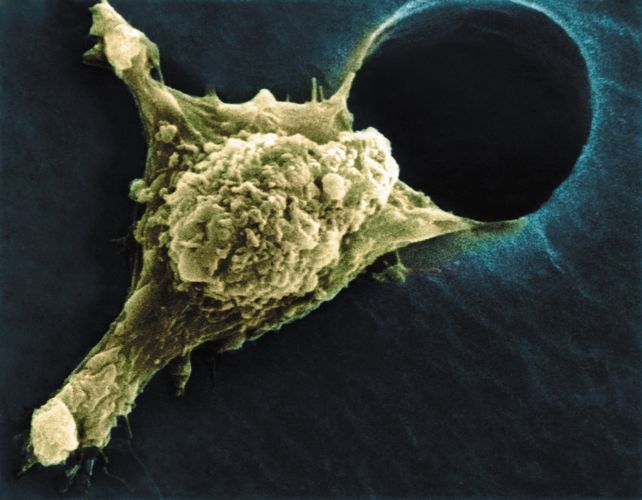Metabolomic Detection of Early-Stage Ovarian Cancer
A detection method for early-stage ovarian cancer has been developed using ultrahigh‑pressure liquid chromatography–high-resolution mass spectrometry (UHPLC–HRMS) in combination with tandem MS–MS.
Photo Credit:

Science Photo Library - SUSAN ARNOLD/ NATIONAL CANCER INSTITUTE/Getty Images
A detection method for early-stage ovarian cancer has been developed using ultrahigh–pressure liquid chromatography–high-resolution mass spectrometry (UHPLC–HRMS) in combination with tandem MS–MS.1 Ovarian cancer is the biggest killer of all gynaecological cancers and the fifth–leading cause of death among women in the United States. Current screening methods are inadequate, requiring lengthy procedures that are inaccurate.
A considerable challenge to researchers, ovarian cancer is “almost always asymptomatic in the early stages,” noted researcher John McDonald of the Georgia Institute of Technology in Atlanta, USA. Survival rates for late-stage ovarian cancer is low but if the disease is detected early, overall survival rates increase dramatically (>92%). “Being able to accurately detect the disease at early stages will make a big difference,” said McDonald.
In developing the new method, researchers used UHPLC–MS and MS–MS in combination with a customized support vector machine to identify 16 diagnostic markers that produced an accuracy level of 100% within the test group. “We are currently initiating studies to determine if our test can prospectively detect ovarian cancer at early stages in high risk women, for example women who are BRCA positive,” said McDonald, referring to mutations of the BRCA 1 and BRCA 2 genes, which are associated with higher risks for breast and ovarian cancer. “The frequency of ovarian cancer onset in these women is quite high, making this a good cohort in which to test the clinical utility of our test,” he continued.
The study results also provide evidence for the importance of lipid and fatty acid metabolism in ovarian cancer. “It’s still not completely clear what the significance is of the observed changes in lipid and fatty acid metabolism in ovarian cancer patients,” McDonald told The Column. “However, there is a growing body of evidence indicating that these changes may play a regulatory role in fostering a cascade of molecular changes that promote the development of ovarian cancer.” It is hoped that targeting the enzymes involved in lipid and fatty acid metabolism will be a promising new area for ovarian cancer therapy in the near future.
The research team are currently planning to expand this study to include a wider range of ethnic and racial groups because of a recognized lack of diversity within the test group. The learning algorithm approach used by the team to identify the biomarkers is designed to identify which metabolites are optimally predictive of disease among the group of women analyzed in the study. “While we strove to include women from broad geographic areas in our study, not all ethnic and racial groups were represented,” he said. “Thus, at this point, we cannot be assured that the 16 biomarkers identified in our study will be 100% accurate in predicting early ovarian cancer across all women.” This may prove difficult because ovarian cancer is rarely identified at the early stages and therefore serum samples are extremely rare. - L.B.
Reference
D.A. Gaul et al., Sci. Rep.5, 16351; doi: 10.1038/srep16351 (2015).

Discovering the Hidden Plastic in Garden Compost with Pyr-GC–MS
May 12th 2025An Australian study used pyrolysis coupled to gas chromatography-mass spectrometry (Pyr-GC–MS) to analyze the presence of plastic polymers in commercial and homemade composts. LCGC International spoke to Simran Kaur—a PhD candidate at the Queensland Alliance for Environmental Health Sciences (QAEHS) at The University of Queensland in Woolloongabba, Australia—to find out more about her team’s findings.

.png&w=3840&q=75)

.png&w=3840&q=75)



.png&w=3840&q=75)



.png&w=3840&q=75)











